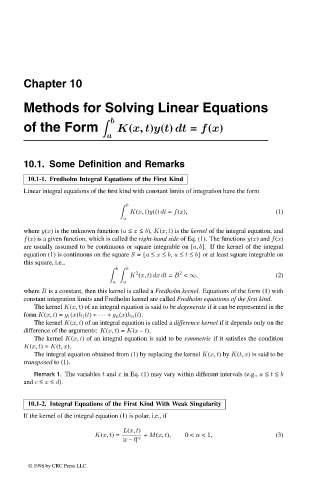Page 509 - Handbook Of Integral Equations
P. 509
Chapter 10
Methods for Solving Linear Equations
b
of the Form K(x, t)y(t) dt = f(x)
a
10.1. Some Definition and Remarks
10.1-1. Fredholm Integral Equations of the First Kind
Linear integral equations of the first kind with constant limits of integration have the form
b
K(x, t)y(t) dt = f(x), (1)
a
where y(x) is the unknown function (a ≤ x ≤ b), K(x, t)isthe kernel of the integral equation, and
f(x) is a given function, which is called the right-hand side of Eq. (1). The functions y(x) and f(x)
are usually assumed to be continuous or square integrable on [a, b]. If the kernel of the integral
equation (1) is continuous on the square S = {a ≤ x ≤ b, a ≤ t ≤ b} or at least square integrable on
this square, i.e.,
b b
2
2
K (x, t) dx dt = B < ∞, (2)
a a
where B is a constant, then this kernel is called a Fredholm kernel. Equations of the form (1) with
constant integration limits and Fredholm kernel are called Fredholm equations of the first kind.
The kernel K(x, t) of an integral equation is said to be degenerate if it can be represented in the
form K(x, t)= g 1 (x)h 1 (t)+ ··· + g n (x)h n (t).
The kernel K(x, t) of an integral equation is called a difference kernel if it depends only on the
difference of the arguments: K(x, t)= K(x – t).
The kernel K(x, t) of an integral equation is said to be symmetric if it satisfies the condition
K(x, t)= K(t, x).
The integral equation obtained from (1) by replacing the kernel K(x, t)by K(t, x) is said to be
transposed to (1).
Remark 1. The variables t and x in Eq. (1) may vary within different intervals (e.g., a ≤ t ≤ b
and c ≤ x ≤ d).
10.1-2. Integral Equations of the First Kind With Weak Singularity
If the kernel of the integral equation (1) is polar, i.e., if
L(x, t)
K(x, t)= + M(x, t), 0 < α < 1, (3)
|x – t| α
© 1998 by CRC Press LLC
© 1998 by CRC Press LLC
Page 491

